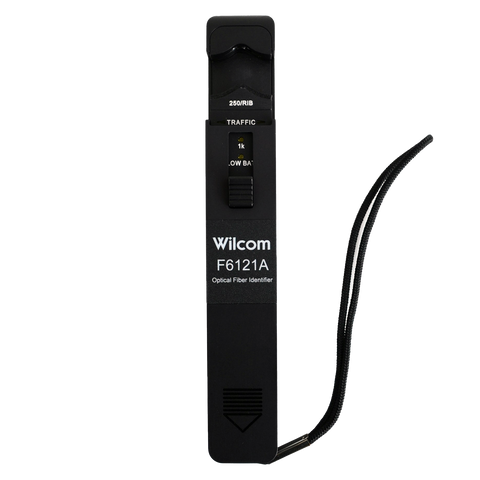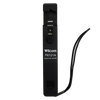Wilcom F6121A Basic Single Mode/Multimode Fiber Identifier
The Wilcom Model F6121A Optical Fiber Identifier identifies optical fibers by detecting the optical signals being transmitted through a single-mode or multimode fiber.
By utilizing local detection technology (non-destructive macro-bend detection), the unit eliminates the need to open the fiber at the splice point for identification; eliminating the probability of interrupting service.
It operates by inserting fiber into the top of the unit which performs a macro-bend on the fiber. This bending technique allows the unit to detect the presence of light and the direction of light.
The Optical Fiber Identifier detects low-frequency tones at 270 Hz, 1000 Hz, and 2000 Hz. When traffic is present on the fiber under test, an audible tone can be heard as well as the traffic direction which is indicated by LEDs illuminating on the probe.
During installations, maintenance, rerouting, or restorations it is often necessary to isolate a specific fiber without disrupting service. A light source such as Wilcom's Model FS1316 used in conjunction with the Optical Fiber Identifier can make the job a lot easier.
The Optical Fiber Identifier includes a carrying pouch containing three easy to use field interchangeable adapter heads to accommodate; 900µm buffered fiber, ribbon or 250µm coated fiber, and 3mm jacketed fiber.
A 2mm optional adapter is also available for testing 2mm cables. It is not included in the standard package and needs to be ordered separately.
Operating Instructions
Introduction
The Wilcom OFI Model F6121A Probe is a rugged, hand-held, easy-to-use maintenance and installation instrument that identifies optical fibers by detecting the optical signals that are transmitted through a singlemode fiber. The F6121A utilizes non-destructive macro-bend detection, which eliminates the need to identify a fiber by opening it at the splice point. Thus, the probability of interrupting service is eliminated.
Signals that the F6121A detect include continuous wave live optical transmission, and
low frequency modulated tones at 270, 1000, and 2000 Hz. When the F6121A detects
traffic on a fiber being tested, one of two LEDs on the F6121A illuminates to indicate
the presence and direction of transmission. The presence of tone is indicated by illumination of one of three LEDs (Figure 1).

The F6121A also has an easy to use thumb lock feature for hands-free operation.
Operating the F6121A
Operation of the F6121A is simple, as outlined in the following steps:
- Choose an adapter head for the type of fiber to be tested.
The F6121A is supplied with three adapters (as shown in Figure 2): (A) foam-covered, to accommodate 900 µm buffered fiber; (B) smooth-surfaced with foam perimeter, for
use with ribbon fiber or a 250 µm coated fiber; and (C) slotted, for 3 mm and optional 2 mm jacketed fiber (i.e., pigtails and jumpers) or loose tube fiber.

2. Select the appropriate adapter and slide it into the mating slotted channel of the F6121A with slight downward pressure, as shown in Figure 3.

3. Insert the fiber to be tested between the adapter and the top of the clamp (refer to Figure 4). Slide the thumb switch upward and ensure that the fiber is installed properly in the alignment groove.

4. For hands-free operation, slide the thumb switch upward and “rock” forward to lock, and the fiber will be held in place ( refer to Figure 4 ) “rock” backward to unlock.
Presence of Traffic. Illumination of either Traffic LED indicates the detection and direction of traffic. This is useful in determining whether the fiber is transmitting or receiving at equipment terminal locations.
The F6121A also provides an audible tone alert when traffic is detected.
Test Tone Detection. Illumination of any one of the 2 kHz, 1 kHz, or 270 Hz LEDs indicates that a test tone is being detected, which ensures accurate identification of the fiber that is under test.
The 2 kHz tone can be generated by a source such as Wilcom Models FS1316 (includes also 1kHz and 270 Hz), FS1317 (includes also 1kHz and 270 Hz), and FS8514A (includes also 1kHz and 270 Hz).
The F6121A can be used with all three units, as shown in Figure 5. The recommended
wavelength is 1550nm for tone identification.

During operation at the lowest levels of tone detection (approximately -40dB core power), the tone LEDs may flicker, which indicates that the minimum range for detection was reached.
Self Test. Each time the thumb switch is operated, the F6121A performs a self test. When this occurs all LEDs will illuminate and then after approximately one-half second turn off.
Low Battery Indication. When the battery voltage becomes low, the “LOW BAT LED” illuminates. The unit will continue to operate for some time, but the battery should
be replaced with a fresh 9-volt alkaline battery as soon as possible.
Battery Replacement. To replace battery hold probe in hand, and with thumb on grip, slide cover downward. Replace battery. To re-install cover reverse the steps. Gently place cover on probe and align cover keys with probe keyways. Slide cover forward.
Maintenance. It is important that the optical ports remain clean and free of dust, dirt, grease, or other foreign matter.
Cleaning with lint-free swabs and isopropyl alcohol is recommended for optimum performance.
Download Product Spec Sheet:






